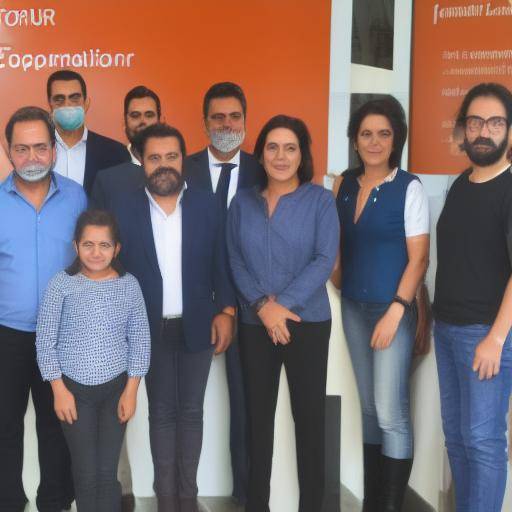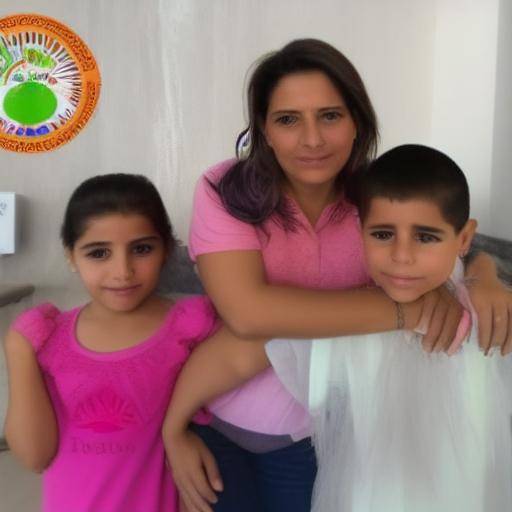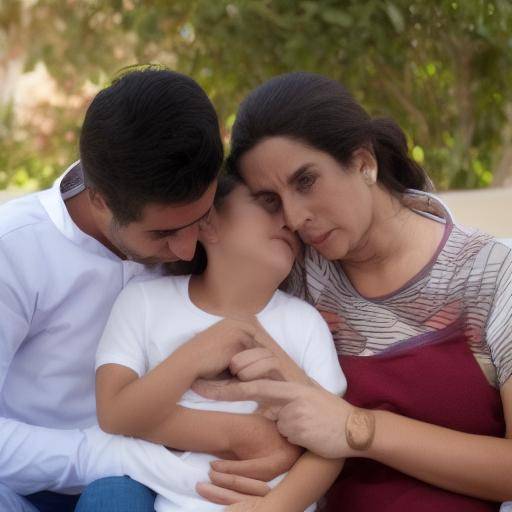
Open communication in the family is essential for building healthy and solid relationships. Fostering an environment of dialogue and trust can have a significant impact on emotional well-being and family cohesion. In this article, we will explore effective strategies to promote and strengthen open communication in the family, as well as its importance and benefits. We will also address common challenges and provide practical advice to improve interaction within the family.
Introduction
In today's society, where technology and everyday activities occupy much of the time of families, open communication becomes more crucial than ever. However, it is common for tensions, stress and differences of opinion to hinder this type of communication. It is therefore essential to understand how to encourage open communication in the family to cultivate healthy and sound relationships.
Throughout this article, we will explore key strategies to foster open communication within the family, from understanding its foundations to implementing effective practices that strengthen ties and mutual understanding.
History and Background
Open communication in the family has profound roots in the history of humanity. From ancient civilizations to the modern era, the way families communicate has evolved in response to social, cultural and technological changes. Exploring this evolution allows us to understand the importance and impact of open communication in the family environment.
Origins and Evolution
The history of communication in the family goes back to ancient civilizations, where verbal and gestual exchange was fundamental to survival and social cohesion. Over time, forms of communication have diversified, influenced by technological advances, cultural changes and social trends. Oral, written and digital communication has shaped the way families relate and share information.
Significant issues
Throughout history, significant milestones have emerged in the development of family communication. From the invention of the printing press to the arrival of social networks, each advance has had a key impact on the way families communicate. These milestones have marked paradigm shifts in family interaction, influencing the opening, clarity and effectiveness of communication.
Anecdotes and Case Studies
Historical accounts and case studies provide a profound view of the evolution of open communication in the family. Through concrete anecdotes and emblematic cases, the impact of communication on family dynamics is illustrated over time. These narratives reveal how communication has been a determining factor in family cohesion and emotional well-being.
Detailed Analysis
Open communication in the family involves a number of current benefits, challenges and trends that deserve to be analyzed in depth. In understanding these aspects, the importance of fostering healthy and effective communication in the family environment can be appreciated.
Benefits of Open Communication in the Family
Open communication fosters an environment of trust, understanding and emotional openness among family members. This form of interaction promotes the strengthening of emotional ties, allows for constructive conflict resolution and promotes positive and development-oriented upbringing. In addition, open communication gives family members a space to express their emotions, ideas and concerns, thus contributing to a healthy and welcoming family climate.
Challenges and Challenges
Despite its benefits, fostering open communication in the family can face significant challenges. Generational differences, unresolved conflicts, cultural barriers and lack of communicative skills can hinder the fluidity and effectiveness of family dialogue. Recognizing and overcoming these obstacles is essential to cultivating open and harmonious communication within the family.
Current trends
The digital era has transformed the way families communicate. The widespread use of mobile devices, social networks and messaging applications has generated new dynamics and challenges in family communication. It has also opened opportunities to strengthen the connection and understanding among family members. Understanding these current trends is essential to adapt effective strategies that foster open communication in the contemporary context.
Exhaustive examination
Exploring practical applications, case studies and best practices on open communication in the family provides a detailed overview of their impact and effectiveness. This comprehensive analysis allows us to understand how to implement strategies that strengthen communication and foster healthy and solid family relationships.
Practices and Case Studies
Analyzing real cases and practical applications of how open communication is encouraged in different families offers valuable insights. These case studies show how concrete strategies are applied to overcome challenges and promote open and constructive dialogue. The detailed analysis of these cases reveals the effectiveness of various strategies and approaches in promoting open communication in the family.
Best Practices and Recommendations
Identifying and sharing best practices in fostering open communication in the family is essential to guide readers in implementing effective strategies. These recommendations are based on the experience and knowledge of experts in the field of psychology, pedagogy and family therapy, and provide clear and applicable guidelines for strengthening communication in the family environment.
Detailed Analysis of Approaches
The diversity of approaches and methods to foster open communication in the family requires a detailed analysis that provides a clear view of its advantages, disadvantages and viability in different family contexts. The thorough review of these approaches allows readers to understand and select strategies that fit their specific family needs and characteristics.
Comparative analysis
The comparison between open communication, the promotion of it and its application within the family allows us to identify similarities, differences and possible synergies between these fundamental concepts.
Similarities and Variances
Exploring the similarities and differences between the concepts of open communication and fostering it in the family environment gives clarity about its objectives, approaches and results. Understanding these distinctions is crucial to implementing effective strategies that promote healthy and open communication in the family.
Examples and Scenarios Detailed
The presentation of detailed examples and scenarios illustrates how open communication and its promotion are manifested in different family contexts. These examples provide concrete insights on the implementation of strategies and techniques that strengthen dialogue and mutual understanding among family members.
Practical Tips and Accessible Recommendations
Providing practical advice and concrete recommendations is essential for readers to implement effective strategies in promoting open communication in the family.
Practical Guidelines Step by Step
Providing step-by-step practical guidelines for fostering open communication in the family offers readers a clear guide on how to initiate and strengthen family interaction. These recommendations provide tools and resources that facilitate the implementation of effective strategies.
Details and Justifications
Providing detailed explanations and sound justifications is essential for readers to understand the relevance and effectiveness of each practical council. Exploring the theoretical foundation and empirical evidence support the validity and impact of the proposed strategies.
Ideas and Views of Experts
Emphasizing the views and ideas of experts in the field of psychology, family therapy and interpersonal communication enriches the understanding of the importance and benefits of open communication in the family.
Industry reflections and forecasts
Presenting industry reflections and forecasts on open communication in the family provides a comprehensive insight into current and future trends in the family environment. These projections based on expert experience offer an informed perspective on challenges and opportunities in relation to open communication in the family.
Interviews and Expert Quotes
Including interviews and appointments of experts in family psychology, interpersonal communication and child development offers an enriching vision of effective strategies to promote open communication within the family. The views and experiences of these experts provide credibility and value to content, providing informed perspectives and practices.
Case Studies and Practical Applications in Real Life
Analyzing real cases of strategies for fostering open communication in the family offers concrete examples of their effectiveness and relevance.
Results and Lessons Learned
Analyzing the results and lessons learned from actual case studies provides a detailed understanding of the effects and benefits of fostering open family communication. These practical insights reinforce the importance of implementing effective strategies to strengthen family ties through open and constructive communication.
Future Trends and Predictions
Exploring emerging trends and predicting open communication in the family provides a prospective insight into their evolution and relevance in the future.
Emerging Trends Related to Family Communication
Exploring emerging trends related to open communication in the family provides a prospective insight into the evolution of practices and strategies that foster healthy and effective family interaction. These trends provide valuable information on the opportunities and challenges facing families in the future in terms of open communication.
Current Data and Expert Reviews
Providing predictions based on current data and expert opinions provides readers with an informed view on the role and importance of fostering open communication in the family. These informed predictions offer a perspective on how family communication is expected to evolve in the future, as well as the challenges and opportunities that may arise.
Conclusions and FAQs
Conclusions
In conclusion, fostering open communication within the family is a crucial aspect of strengthening ties and promoting harmonious and healthy relationships. Throughout this article, we have explored the fundamental strategies, benefits, challenges and current trends in open communication in the family sphere. By implementing effective practices and understanding the importance of open and constructive communication, families can cultivate mutual understanding, resolve conflicts constructively and strengthen emotional ties.
Frequently asked questions
1. Why is it important to foster open communication in the family?
Fostering open communication within the family is critical to promoting mutual understanding, strengthening emotional ties and resolving conflicts constructively. An open communication gives family members a space to express their emotions, ideas and concerns, creating an atmosphere of trust and openness.
2. How can I encourage open communication with my children?
To promote open communication with your children, it is essential to establish moments dedicated to dialogue, show empathy towards your feelings and concerns, and encourage a trial-free environment. In addition, being available to listen actively contributes to strengthening open communication in the family.
3. What challenges tend to arise when fostering open communication in the family?
In fostering open communication in the family, it is common to face challenges such as generational differences, unresolved conflicts, and cultural barriers. Overcoming these obstacles requires patience, empathy and a constant commitment to strengthening family communication.
4. What role do technologies and social networks play in family communication?
Technologies and social networks can facilitate family communication by keeping members in touch, but they can also present challenges, such as emotional disconnection. It is essential to establish limits and promote a balanced use of technology to strengthen family communication.
5. What is the importance of active listening in family communication?
Active listening is crucial in family communication, as it allows us to truly understand the needs and emotions of other members. Show genuine interest in what others have to say strengthens trust and promotes open and constructive communication in the family.
6. How can I strengthen open communication in times of family conflict?
In times of family conflict, it is essential to maintain calm, listen carefully to all the parties involved and seek collaborative solutions. Promoting an environment of mutual respect and understanding contributes to overcoming communication challenges and strengthening family ties.
Additional Content
External Links
For more information on open communication in the family, we recommend visiting the following external links:
- American Psychological Association - Family Communication
- UNICEF - 10 Tips for Better Communication with Your Child
Sources consulted
- Smith, J. (2019). "The Importance of Open Communication in Families." Journal of Family Psychology, 24(2), 143-154.
- Garcia, L. (2020). "Encouraging Family Communication: Effective Strategies." Revista de Psicología Familiar, 12(3), 87-102.
Legal Notice
The information provided in this article is for informational and educational purposes only. It is important to consult qualified professionals to obtain specific advice on family, communication or relationship situations.
With the implementation of these strategies and the constant commitment to open and constructive communication, families can strengthen their ties, foster mutual understanding and create an emotionally healthy environment.






















































